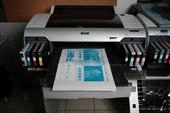Consumables
VIM Technologies announces revolutionary offset plates for imaging by standard inkjet printers

Monday 12. May 2008 - At Drupa VIM Technologies is introducing a completely new range of metal and polyester offset plates that are imaged by standard inkjet printers and their aqueous pigment ink.
With the VIM JT Direct Inkjet Plates, VIM has implemented its years of research and experience in direct digital offset plate imaging to create an affordable processless computer-to-plate (CtP) solution suitable for any offset press. Plate production and printed samples will be demonstrated on VIM Technologys stand at Drupa (Hall 7a stand 9B).
VIM predicts that JT Direct Inkjet Plates will provide the lowest cost of ownership compared with any other CtP system. The initial investment is simply the cost of a standard high quality aqueous inkjet printer (initially one of the highly affordable Epson Stylus Pro range), together with an off-the-shelf pre-press Rip-workflow solution and a simple heating system.
The VIM JT Direct Inkjet Plates will be available in both aluminum sheets and polyester roll materials for standard wet offset litho presses. The plates have a special coating to accept standard inkjet pigment-based inks.
“This is a technical breakthrough, as previous inkjet-imaged plates from other suppliers have required that a special imaging inks is used,” says Avigdor Bieber, founder and CEO of VIM Technologies. “Because we use standard inks the printers warranty is preserved. It also means that the same printer can still be used for conventional full-colour proofing, so it can act as a proofer for the plates, saving space and money.
VIM is already well-established in the processless plates market with its VIM DP-R range of polyester plates for direct imaging waterless litho presses. At Drupa it will also be introducing DP-S, a processless aluminium waterless plate, that can be imaged in any standard thermal platesetter (see separate press release).
“Imaging the VIM JT Direct Inkjet Plates is both easy and completely free of hazardous chemicals and solvent based inks,” Mr Bieber states. “After running through the inkjet they are simply heated in a low-cost heating unit to harden the image-forming area.” The plates can then go onto the press for use with standard inks, fountain solutions and cleaning chemicals.
Initially the plates will be suitable for run lengths up to 10,000 impressions. VIM Technologies is working on future materials with a target of 30,000 impressions.
Plates will be available in a choice of sizes from 2-up (which can be imaged in a 17 inch printer such as the Epson Stylus Pro 4880) and 4-up (for the Epson Stylus Pro 7880). These are completely standard off-the-shelf printers that can be purchased by printers worldwide. Previous generations of Epson Stylus Pro UltraChrome models can also be used. VIM is now developing plates for Canons imagePROGRAF inkjets and plans to produce materials for HP Designjets in future.
Metal plates are fed either from cassette or manually, through the standard single-sheet pass-through slot on the Epson printers. VIM supplies a support/guide for the feed slot that helps support the heavier material and ensure accuracy. The plates are dimensionally stable and suited for close-register multi-colour process printing.
The plastic plates can be fed from the standard roll feeder of the Epsons, and after imaging they are cut to length by the printers built-in sheet cutter.
Todays Epson Stylus Pro range has resolutions up to 2,880 x 1,440 dpi and variable ink droplets down to 3.5 picolitres, which Mr Bieber says is suitable for screen rulings equivalent to 150 lpi on the JT Direct plates, although stochastic/FM rather than conventional AM screening could also be used.
Any Rip/workflow software that can drive Epson printers can be used with the JT Direct Inkjet Plates.
VIM JT Direct Inkjet Plates will be available from Q4 2008 through VIMs international network of dealers and distributors.
